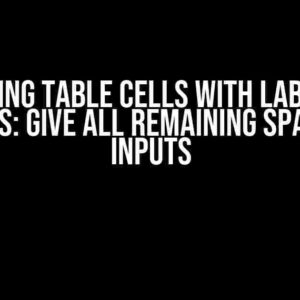Are you tired of dealing with the frustrating issue of regenerating the same component in Builder.io? You’re not alone! This common problem can be a major roadblock for developers, causing unnecessary delays and headaches. But fear not, dear reader, for we’ve got you covered. In this comprehensive guide, we’ll dive into the world of Builder.io and provide you with the expert tips and tricks you need to avoid regenerating the same component.
What is Builder.io and Why Does it Regenerate Components?
Before we dive into the solution, let’s take a quick look at what Builder.io is and why it regenerates components in the first place.
Builder.io is a powerful visual development platform that allows users to build custom applications without coding. It’s a revolutionary tool that enables developers to focus on what matters most – building amazing applications – rather than getting bogged down in tedious coding.
However, one of the most common issues developers face when using Builder.io is the regenerating of components. This occurs when Builder.io re-renders a component unnecessarily, causing delays and slowing down the development process.
The Consequences of Regenerating Components
So, why is regenerating components such a big deal? Let’s take a look at the consequences:
- Slow Development Speed: Regenerating components can significantly slow down the development process, causing frustration and delays.
- Increased Resource Usage: Re-rendering components unnecessarily can consume more resources, leading to higher costs and slower performance.
- Decreased Productivity: When components are re-generated, developers have to re-do their work, leading to decreased productivity and wasted time.
Tips and Tricks to Avoid Regenerating Components
Now that we’ve covered the consequences, let’s dive into the good stuff – the tips and tricks to avoid regenerating components in Builder.io:
Use the `key` Prop
One of the simplest ways to avoid regenerating components is by using the `key` prop. This prop helps Builder.io identify the component and prevent re-rendering. Here’s an example:
<div key="my-component" > <!-- your component code here --> </div>
By adding the `key` prop, you’re telling Builder.io to keep track of the component and avoid re-rendering it unnecessarily.
Use `shouldComponentUpdate`
Another way to prevent component re-rendering is by using the `shouldComponentUpdate` method. This method allows you to control when a component should be re-rendered. Here’s an example:
class MyComponent extends React.Component {
shouldComponentUpdate(nextProps, nextState) {
return nextProps.data !== this.props.data;
}
render() {
return <div>{this.props.data}</div>;
}
}
In this example, the component will only re-render when the `data` prop changes, reducing unnecessary re-renders.
Optimize Component State
Component state can be a major culprit when it comes to regenerating components. To avoid this, make sure to optimize your component state by using immutable data structures and avoiding unnecessary state changes.
class MyComponent extends React.Component {
state = {
data: []
};
handleDataChange = (newData) => {
this.setState({ data: newData.slice() });
};
render() {
return <div>{this.state.data}</div>;
}
}
By using immutable data structures and avoiding unnecessary state changes, you can significantly reduce the likelihood of component re-rendering.
Use `React.memo`
React.memo is a higher-order component that memoizes the component’s render output. This means that if the component’s props haven’t changed, it won’t re-render. Here’s an example:
import { memo } from 'react';
const MyComponent = memo((props) => {
return <div>{props.data}</div>;
});
By using React.memo, you can ensure that your component only re-renders when its props change.
Avoid Using `Math.random()`
Using `Math.random()` can be a major culprit when it comes to regenerating components. This is because `Math.random()` generates a new value every time it’s called, causing the component to re-render unnecessarily. Instead, use a unique identifier or a static value.
const MyComponent = () => {
const id = 'my-component-' + (new Date().getTime());
return <div id={id}></div>;
};
Use a `componentDidUpdate` Hook
The `componentDidUpdate` hook is called after the component has updated. You can use this hook to check if the component’s props have changed and re-render only when necessary. Here’s an example:
class MyComponent extends React.Component {
componentDidUpdate(prevProps) {
if (prevProps.data !== this.props.data) {
// re-render the component
}
}
render() {
return <div>{this.props.data}</div>;
}
}
Optimize Your Build Config
Last but not least, make sure to optimize your build config to reduce the likelihood of regenerating components. Here are some tips:
- Use a production build: A production build will help to reduce the size of your code and minimize re-renders.
- Use code splitting: Code splitting can help to reduce the amount of code that needs to be re-rendered.
- Use a caching layer: A caching layer can help to reduce the number of re-renders by storing frequently accessed data.
Common Pitfalls to Avoid
When trying to avoid regenerating components, there are some common pitfalls to avoid:
| Pitfall | Description |
|---|---|
| Using ` componentWillReceiveProps` | This method is deprecated and can cause unnecessary re-renders. |
| Using `shouldComponentUpdate` excessively | This can lead to performance issues and slow down your application. |
| Not optimizing component state | Unnecessary state changes can cause re-renders and slow down your application. |
Conclusion
Avoiding regenerating components in Builder.io is crucial for building fast, efficient, and scalable applications. By following the tips and tricks outlined in this guide, you can significantly reduce the likelihood of component re-rendering and improve your development speed.
Remember, the key to avoiding regenerating components is to understand how Builder.io works and to use the right tools and techniques to optimize your component rendering. With practice and patience, you’ll be building lightning-fast applications in no time!
Here are 5 Questions and Answers about “How to avoid regenerating same component in Builder.io” in a creative voice and tone:
Frequently Asked Questions
Get the inside scoop on how to avoid regenerating the same component in Builder.io, and take your development game to the next level!
How do I prevent Builder.io from regenerating the same component multiple times?
To avoid regenerating the same component in Builder.io, make sure to assign a unique `key` prop to each component instance. This tells Builder.io to treat each instance as a distinct entity, preventing unnecessary re-renders.
What’s the deal with memoization in Builder.io, and how can it help me?
Memoization is a technique that caches the results of expensive function calls, so they can be reused instead of recomputed. In Builder.io, memoization can help you avoid regenerating the same component by storing the component’s props and state in memory. This way, when the component is re-rendered, Builder.io can simply retrieve the cached result instead of recomputing it.
Can I use `shouldComponentUpdate` to control when my component is regenerated in Builder.io?
You bet! By implementing the `shouldComponentUpdate` method in your component, you can decide when it should be re-rendered or not. This gives you fine-grained control over the regeneration process, ensuring that your component is only updated when necessary.
How do I optimize my component’s dependencies to minimize regeneration in Builder.io?
To optimize your component’s dependencies, make sure to only import what’s necessary, and use lazy loading for dependencies that aren’t critical to the component’s initial render. This reduces the likelihood of unnecessary re-renders, and helps Builder.io regenerate your component more efficiently.
What’s the role of `React.memo` in avoiding regeneration in Builder.io?
`React.memo` is a higher-order component that helps prevent unnecessary re-renders by memoizing the component’s props and state. By wrapping your component with `React.memo`, you ensure that it’s only regenerated when its props or state change, reducing unnecessary regeneration in Builder.io.







